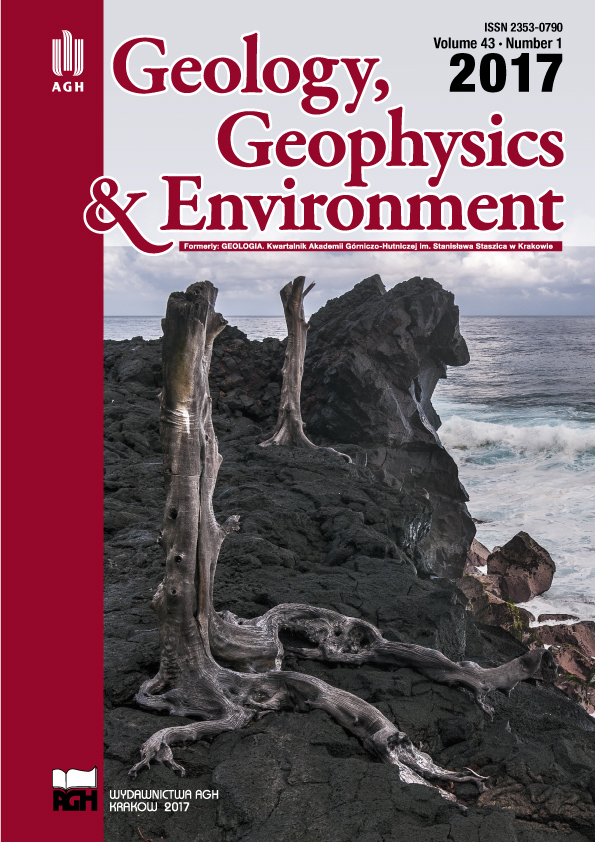New data on celestine-rich salts in the Wieliczka salt deposits
DOI:
https://doi.org/10.7494/geol.2017.43.1.57Keywords:
rock salt, Badenian, Wieliczka, strontium, celestine, geochemistryAbstract
Pale brownish celestine-rich salt rocks were found near the Franciuszek Müller gallery, in the chambers of the 3rd level in the Wieliczka Salt Mine. The complex of rock salts subjected to exploration occurred within a large seam approximately 15 m thick. Detailed research revealed that the salt has the form of a block incorporated within the gray salts body and being similar to other blocks of green salts, well known in the upper part of the deposit. A characteristic petrographical feature of the pale brown rock salt owed to the presence of celestine (SrSO 4 ). That strontium mineral was re-examined, using X-ray powder data, and scanning microscope observations, with EDS analysis. The investigated rock salts exhibited a mineral association of halite (main component), anhydrite, celestine, calcite, gypsum, clay materials, iron compounds and a small amount of bitumen. Interrigenous sediments and the insoluble part of salt occurred higher content of strontium that in halite. Celestine crystals were observed in two forms: elongated platy crystals, forming fan-shaped aggregates and granular aggregates, strongly associated with anhydrite. On carbonate and sulphate strontium usually appearing as needle shaped aggregates of celestine. No barium minerals were observed. The development and paragenesis of celestine suggested a post-sedimentary origin of these rocks that ought to be connected with diagenetic processes. An important observation that confirmed that thesis was the transformation of fine crystalline anhydrite into platy crystals, recrystallization and primary accumulation of strontium, as a result of evaporation processes.Downloads
References
Alexandrowicz Z., 2000. Zarys budowy geologicznej wielickiego złoża soli. [in:] Alexandrowicz Z. (red.), Groty Kryształowe w Kopalni Soli Wieliczka, PAN IOP, Kraków, 11–19.
Báldi K., Velledits F., Ćorić S., Lemberkovics V., Lőrincz K. & Shevelev M., 2017. Discovery of the Badenian evaporites inside the Carpathian Arc: implications for global climate change and Paratethys salinity. Geologica Carpathica, 68, 3,193–206.
Borkowska M. & Smulikowski K., 1973. Minerały skałotwórcze. Wydawnictwa Geologiczne, Warszawa.
Bukowski K., 2011. Badeńska sedymentacja salinarna na obszarze między Rybnikiem a Dębicą w świetle badań geochemicznych, izotopowych i radiometrycznych. Rozprawy, Monografie – Akademia Górniczo-Hutnicza im. Stanisława Staszica, 236, Wyd. AGH, Kraków.
Brudnik K., Przybyło J. & Stecka J.,2000 Budowa geologiczna i warunki hydrogeologiczne rejonu Grot Kryształowych. [in:] Alexandrowicz Z. (red.), Groty Kryształowe w Kopali Soli Wieliczka, PAN IOP, Kraków, 35–58.
Dudek K., Bukowski K. & Wiewiórka J., 2004. Datowania radiometryczne badeńskich osadów piroklastycznych z okolic Wieliczki i Bochni. [in:] Michalik M., Jacher-Śliwczyńska K., Skiba M. & Michalik J. (red.), Datowanie minerałów i skał: VIII Ogólnopolska Sesja Naukowa, Kraków, 18–19 listopada 2004, Kraków, 19–26.
Garlicki A., 1979. Sedymentacja soli mioceńskich w Polsce. Prace Geologiczne – Polska Akademia Nauk. Oddział w Krakowie. Komisja Nauk Geologicznych, 119, Zakład Narodowy im. Ossolińskich, Wrocław – Kraków.
Gaweł A., 1962. Budowa geologiczna złoża solnego Wieliczki. [in:] Czaplicka J. et al. (red.), Czterdzieści lat Instytutu Geologicznego 1919–1959. Cz. 3, Prace - Instytut Geologiczny, 30, Wydawnictwa Geologiczne, Warszawa, 305–332.
Herrmann A.G., 1961. Zur Geochemie des Strontiums in den salinaren Zechsteinablagerungen der Stassfurt - Serie des Südharzbezirkes. Chemie der Erde, 21, 137–192.
de Leeuw A., Bukowski K., Krijgsman W. & Kuiper K.F., 2010. Age of the Badenian salinity crisis; impact of Miocene climate variability on the circum Mediterranean region. Geology, 38, 8, 715–718.
Kolasa K. & Ślączka A., 1985. Sedimentary salt megabreccias exposed in the Wieliczka mine, Fore-Carpathian Depression. Acta Geologica Polonica, 35, 3–4, 221–230.
Mikheyev V.I., 1957. Rentgenometricheskiy opredelitel‘ mineralov. Gosudarstvennoyenauchno-tekhnicheskoye izdatel‘stvo literatury po geologii i okhrane nedr, Moskva [Михеев В.И., 1957. Рентгенометрический определитель минералов. Государственное научно-техническое издательство литературы по геологии и охране недр, Москва].
Müller G., 1962. Zur Geochemie des Strontiums in ozeanen Evaporiten unter besonderer Berücksichtigung der sedimentären Coelestin lagerstätte von Hemelte-West (Süd-Oldenburg). Geologie, 35,1-90.
Noll W., 1934. Geochemie des Strontiums. Chemie der Erde, 16, 507-600.
Prochazka K., Wala A. & Wiewiórka J., 1969. Sole kamienne ze strontem i barem w złożu solnym Wieliczka. Prace Mineralogiczne, 9218, Wydawnictwa Geologiczne, Warszawa.
Strunz H., 1966. Mineralogische Tabellen. Akademische Verlags-Gesellschaft.
Turekian K.K. & Kulp J.L., 1956. The geochemistry of strontium. Geochimica et Cosmochimica Acta, 10, 245–296.
Turekian K.K. & Wedepohl K.H., 1961. Distribution of the Elements in some major units of the Earth’s crust. Geological Society of America, 72, 175–192.
Pawlikowski M., 1978. Badania petrograficzne złoża solnego Wieliczki (Petrographic studies on the Wieliczka Salt Deposit). Prace Mineralogiczne, 58, Zakład Narodowy im. Ossolińskich, Wrocław – Kraków, 65–124.
Peryt T., 2006. Sedymentacja ewaporatów badeńskich w zbiorniku przedkarpackim. Przegląd Geologiczny, 54, 438–444.
Usdowski E., 1973. Das geochemische Verhalten des Strontiums bei tier Genese und Diagenese von Ca-Karbonnt- und Ca-Sulfat-Mineralen. Contributions to Mineralogy and Petrology, 38, 1, 177–195.
Wiewiórka J., 1973. Poziom najstarszej soli kamiennej w pokładowym złożu solnym Wieliczki. Studia i Materiały do Dziejów Żup Solnych w Polsce, 3, 46–58.
Zherebtsova I.K. & Volkova N.N., 1966. Experimental study of behaviour of trace elements in the process of natural solar evaporation of Black Sea and Sasyk-Sivash brine. Geochemistry International, 3, 656–670.
Downloads
Published
Issue
Section
License
Authors have full copyright and property rights to their work. Their copyrights to store the work, duplicate it in printing (as well as in the form of a digital CD recording), to make it available in the digital form, on the Internet and putting into circulation multiplied copies of the work worldwide are unlimited.
The content of the journal is freely available according to the Creative Commons License Attribution 4.0 International (CC BY 4.0)










